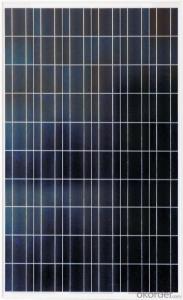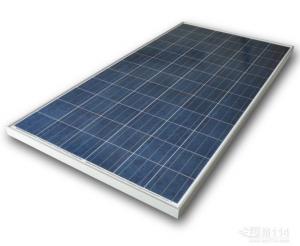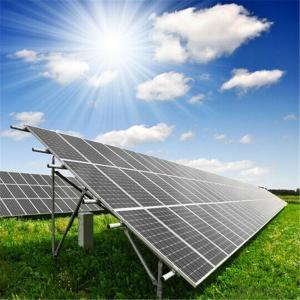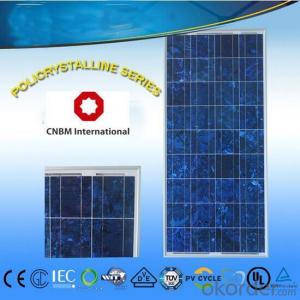Purchase or Lease Polycrystalline Solar Module 250W
- Loading Port:
- China Main Port
- Payment Terms:
- TT OR LC
- Min Order Qty:
- -
- Supply Capability:
- -
OKorder Service Pledge
OKorder Financial Service
You Might Also Like
Solar Monocrystalline (210W-225W)
Introduction of Solar Monocrystalline (210W-225W)
Solar modules use light energy (photons) from the sun to generate electricity through the photovoltaic effect. The majority of modules use wafer-based crystalline silicon cells or thin-film cells based on cadmium telluride or silicon. The structural (load carrying) member of a module can either be the top layer or the back layer. Cells must also be protected from mechanical damage and moisture. Most solar modules are rigid, but semi-flexible ones are available, based on thin-film cells. These early solar modules were first used in space in 1958.
CNBM Solar photovoltaic (PV) Panel is designed for large electrical power requirements. It is the optimal choice for both on-grid and off-grid power systems. CNBM Solar panel offers high performance of power per square foot of solar array. Monocrystalline silicon(c-Si): often made using the Czochralski process. Single-crystal wafer cells tend to be expensive, and because they are cut from cylindrical ingots, do not completely cover a square solar cell module without a substantial waste of refined silicon. Hence most c-Si panels have uncovered gaps at the four corners of the cells.
Characteristics of Solar Monocrystalline (210W-225W)
I. Solar Cell : High efficiency crystalline solar cell. Even if under the weak light, the solar module can produce maximum power output.
II. Tempered glass (toughened glass): Anti-reflecting coating and high transmission rate glass increase the power output and mechanical strength of solar module.
III. EVA and TPT: Using high quality EVA and TPT to prevent destroying and water.
IV. AI frame: Without screw, corner connection. 6 holes on the frame can be installed easily.
V. Junction box: Multi function junction box with water proof.
VI. Long lifetime: ≥25 years; Less power decrease.
VII. Good performance of preventing from atrocious weather such as wind and hails.
VIII. Resisting moisture and etching effectively, not effected by geology.
IX. The certificate issued by international authority: UL, TUV, IEC, VDE, CE.
Standard Test Conditions of Solar Monocrystalline (210W-225W)
The opto-electrical specifications shown below are stabilized values being measured at Standard Test Conditions, Irradiance: 1000W/m2, Spectrum: AM1.5 at 25°C, The info below is subject to manufacturing tolerances. Where appropriate minutes of measurement are available and are used for the dimensioning of the installation.
Advantages of Solar Monocrystalline (210W-225W)
• CNBM Solar performance guarantees for 25 years
• 10 years guarantee for workmanship
• Timeliness of delivery
• Quality Products certified (TÜV, UL, CE, VDE, ISO)
CNBM International Corporation's products including Monocrystalline Solar Panel, Polycrystalline Solar Panel have received and enjoyed famous reputation in many countries and regions in the world .As a solar panel manufacturer in China, we strive to provide our customers with excellent service, superior products and unmatched value.
- Q: I've seen a couple homes around my town that have solar power and I live in the Desert, where the sun is shinning and it gets really hot during the summer. We run our air conditioner a lot making our electricity bill high.So I just wanted to know if anyone has or knows anyone that has solar panels? are they worth getting and is it the same as having electricity?
- and, if given the tax credits, you'll see a faster return on investment in CA than I would have in Western PA (I was given a 0 year return number without factoring any tax credits). Plus you'll be doing something good for the environment. My brother put his house for sale which had solar panels for hot water, and was offered good money for the solar panels independent of selling the house. If anyone has a any no answer that doesn't involve the initial expense, I'm looking forward to reading it.
- Q: Can solar panels be used in areas with extreme temperatures?
- Yes, solar panels can be used in areas with extreme temperatures. Solar panels are designed to withstand a wide range of temperatures, including both extreme heat and cold. However, it's important to note that extreme temperatures can affect the efficiency and performance of solar panels. High temperatures can cause a slight reduction in energy output, while extremely low temperatures can decrease the efficiency temporarily. Nonetheless, solar panels are still a viable and effective renewable energy solution in areas with extreme temperatures.
- Q: Can solar panels be installed on a sports stadium?
- Yes, solar panels can be installed on a sports stadium.
- Q: Can solar panels be used in areas with high levels of hurricanes?
- Yes, solar panels can be used in areas with high levels of hurricanes. However, it is crucial to ensure that the solar panel installation is designed and built to withstand strong winds and other extreme weather conditions. This can be achieved through proper engineering, using sturdy mounting systems, and adhering to local building codes and regulations.
- Q: I'm doing a project for school and I'm a little confused about energy and solar panels. I'm looking to propose installation of solar panels to power the computer lab at my school. From what I've read a computer and monitor use roughly 350 watts per hour. I was looking at solar panels and it says they produce various wattage. For example, I was looking at one rated at 200 watts. Does that mean 200 watts in a day? Or per hour? Please help.
- The rating of a solar panel is a maximum continuous rating. A 200 Watt panel will give a maximum of 200 watts under ideal conditions. A computer and monitor use about 400 Watts. not per hour - watts is Volts * Amps and a measure of Power. In hour a computer and monitor uses 400 Watt hours (Wh). Wh is a measure of Energy. To power a lab of 0 computers you will need 0* 400 = 4000 Watts. To run this from solar panels through the day only you would need a 4000 Watt panel. Except - its cloudy, the sun is in the wrong place - many factors reduce the output. To be reasonably safe you would need about a 2000 Watt panel. Then you would need batteries to store power through dull periods AND a voltage converter to change from low voltage DC from the solar panels to the mains voltage for your computers.
- Q: Can solar panels be installed on a library or educational institution?
- Yes, solar panels can be installed on a library or educational institution. In fact, many libraries and educational institutions have already embraced solar energy and installed solar panels on their rooftops or surrounding areas. This helps them reduce their carbon footprint, save on electricity bills, and serve as a sustainable example for the community.
- Q: I have a home made 24 volt electric cart. It is powered by two 2Volt deep cycle batteries. Since the motor runs on 24 volts the batteries are wired in series to produce the 24 volts. I only have a 2 volt battery charger, but I also have two 2 volt solar panels. It is a pain having to unhook wires, rewire it, or charge them one at the time.HERE IS THE QUESTION REALLY... Can I wire the two 2 volt solar panels together in series (ie: negative to positive) then connect it to the existing 24 volt system and have it charge the batteries fine. I know basic wiring, but I know nearly nothing about solar panels, will it work fine? will it cause them to break? or short out?(additional info, the solar panels are only rated at 5 amps so it will not overcharge the batteries or anything)
- Although I'm not experienced with solar panels, I would say no. if you wire them in series you'll actually be putting voltage through one of the panels. Can't believe this would be good. My suggestion would be to wire one panel to one battery and one panel to the other battery. I really don't believe there's a need to disconnect the batteries from each other. However if you would disconnect the one wire between the two batteries you would be guaranteed safe and I know that would work.
- Q: so...do you think an online store dedicated to selling solar panels/systems will be a good business idea? Since green energy is the 'hottest' growing business area recently with usage growing about 30% per annum and investors putting all their money into solar energy, wind farms, biofuel, etc. I think when you sell solar systems online this will be the most appealing business model to the end customer...especially if you offer free installation on orders of say $000.
- It's that offering installation that is the problem. Do you have the ability to arrange contractors to install where ever the customer may be? The online store model works best on a drop ship model where once you've shipped the parcel, you're done. Online selling of solar panels would be basically to the DIY crowd and as you've said, most people don't have the skills nor the enthusiasm to install them. The current price per watt installed is about $0 a watt. $ per watt are the organic dye and film solar panels which are horrendously inefficient and require much more square footage and that $ per watt price is before installation. Currently solar depends a lot on government subsidies to be worthwhile. The various green energy technologies (both solar and wind) lack the economics to be anything other than greenwashing and often if you consider the total impact to the environment, they are often worse than fossil fuels and even if the environmental impact of their manufacture is neglected, it's hard to compete with fossil fuels where nature has done all the work of storing solar energy in a convenient hydrocarbon form. Of course, there's still money to be made off people's ignorance. You've already asked this question several times, apparently you're not satisfied with any answers that are counter to your hopes. Why don't you try it and see how far you'll get.
- Q: Can solar panels be used in areas with limited access to electricity?
- Yes, solar panels can be used in areas with limited access to electricity. Solar panels can generate electricity from sunlight, allowing them to provide a reliable source of power in remote or off-grid locations. These areas can benefit greatly from solar energy as it is a sustainable and renewable resource that can help meet their energy needs.
- Q: Are there any risks of fire associated with solar panels?
- Yes, there are certain risks of fire associated with solar panels, although they are relatively low compared to other energy sources. Potential causes of fire include electrical malfunctions, improper installation or maintenance, and damage from external factors such as lightning or extreme weather conditions. However, modern solar panel systems are designed with safety measures in place to minimize these risks, including fire-resistant materials and enhanced electrical protection. Regular inspections and adherence to installation guidelines can further reduce the chances of fire incidents.
Send your message to us
Purchase or Lease Polycrystalline Solar Module 250W
- Loading Port:
- China Main Port
- Payment Terms:
- TT OR LC
- Min Order Qty:
- -
- Supply Capability:
- -
OKorder Service Pledge
OKorder Financial Service
Similar products
Hot products
Hot Searches
Related keywords























